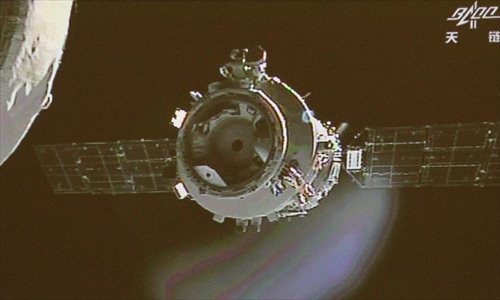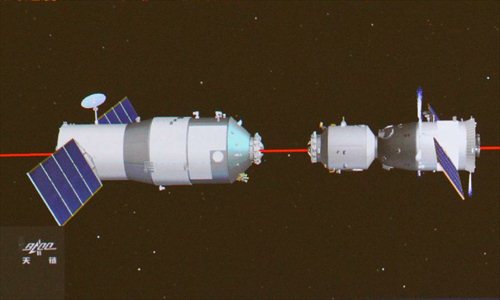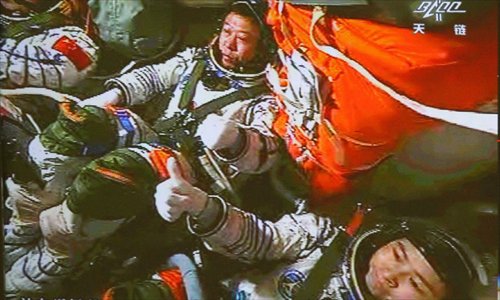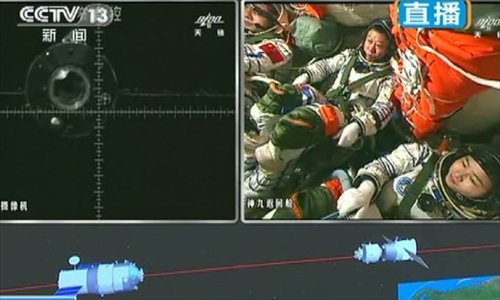China's first space manual docking successful
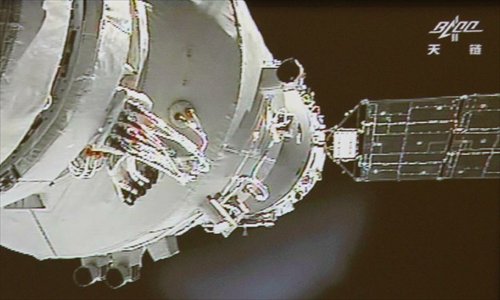
Three Chinese astronauts Sunday successfully completed a manual docking between the Shenzhou-9 spacecraft and the orbiting Tiangong-1 lab module, the first such attempt in China's history of space exploration.
It means China has completely grasped space rendezvous and docking technologies and the country is fully capable of transporting humans and cargo to an orbiter in space, which is essential for building a space station in 2020.
Astronaut Liu Wang, assisted by his teammates Jing Haipeng and Liu Yang, controlled the Shenzhou-9 spacecraft to dock with the Tiangong-1 space lab module at 12:48 p.m., which were reconnected about seven minutes later.
About one and a half hours before the docking, the Shenzhou-9 parted from the Tiangong-1 to a berth point 400 meters away from the module.
To leave room for adjustment, engineers set up four berth points for the spaceship on the same orbit five km, 400 meters, 140 meters and 30 meters away from the orbiting lab.
A highly sophisticated space manoeuvre, manual docking requires the astronaut to connect together two orbiters traveling at 7.8 kilometers a second in space without a hitch.
Shortly after the docking, the smiling astronauts greeted the ground crew via camera by waving, hand in hand.
The astronauts, 343 km away from the Earth, were also greeted by Chinese oceanauts from the Mariana Trench, 7,015 meters beneath the Pacific Ocean, where they just refreshed the country's dive record in a manned submersible on Sunday morning.
"We wish for a great success of the manual docking and brilliant achievements in China's manned space and manned deep-sea dive causes," reads the message sent by three oceanauts aboard the manned submersible Jiaolong.
The astronauts will return to the Tiangong-1 lab module from the Shenzhou-9 spacecraft hours after the manual docking procedure to continue with experiments and research in space.
The spacecraft and the space lab were joined together by an automated docking on June 18. The three astronauts, including the country's first female astronaut, Liu Yang, were sent into space onboard Shenzhou-9 on June 16 from a launch center in northwest China's Gobi desert.
China succeeded in an automated space docking between the unmanned spaceship Shenzhou-8 and the Tiangong-1 late last year.
"The automated docking and manual docking are both essential and they serve as a backup for each other," said Zhou Jianping, designer-in-chief of China's manned space program.
The manual docking is a significant step for China's manned space program that celebrated its 20th anniversary this year, as China has fully grasped space travel, space walk and space rendezvous and docking technologies that are essential to building a space station, Zhou said.
China is the third country, after the United States and Russia, to acquire technologies and skills necessary for space rendezvous and docking and be able to supply manpower and material to an orbiting module via different docking methods.
The Shenzhou-9 spacecraft is scheduled to part from the Tiangong-1 module manually 4 days later and take the three astronauts back to the earth on June 29, which would set a record for the longest space travel in the history of China's manned space program.
